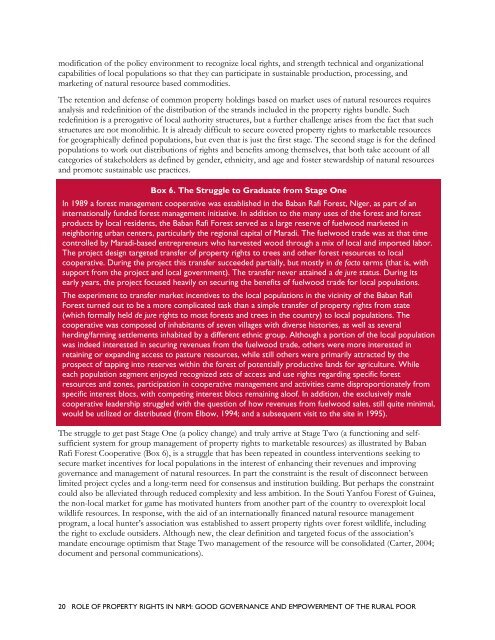the role of property rights in natural resource management, good ...
the role of property rights in natural resource management, good ...
the role of property rights in natural resource management, good ...
Create successful ePaper yourself
Turn your PDF publications into a flip-book with our unique Google optimized e-Paper software.
modification <strong>of</strong> <strong>the</strong> policy environment to recognize local <strong>rights</strong>, and strength technical and organizationalcapabilities <strong>of</strong> local populations so that <strong>the</strong>y can participate <strong>in</strong> susta<strong>in</strong>able production, process<strong>in</strong>g, andmarket<strong>in</strong>g <strong>of</strong> <strong>natural</strong> <strong>resource</strong> based commodities.The retention and defense <strong>of</strong> common <strong>property</strong> hold<strong>in</strong>gs based on market uses <strong>of</strong> <strong>natural</strong> <strong>resource</strong>s requiresanalysis and redef<strong>in</strong>ition <strong>of</strong> <strong>the</strong> distribution <strong>of</strong> <strong>the</strong> strands <strong>in</strong>cluded <strong>in</strong> <strong>the</strong> <strong>property</strong> <strong>rights</strong> bundle. Suchredef<strong>in</strong>ition is a prerogative <strong>of</strong> local authority structures, but a fur<strong>the</strong>r challenge arises from <strong>the</strong> fact that suchstructures are not monolithic. It is already difficult to secure coveted <strong>property</strong> <strong>rights</strong> to marketable <strong>resource</strong>sfor geographically def<strong>in</strong>ed populations, but even that is just <strong>the</strong> first stage. The second stage is for <strong>the</strong> def<strong>in</strong>edpopulations to work out distributions <strong>of</strong> <strong>rights</strong> and benefits among <strong>the</strong>mselves, that both take account <strong>of</strong> allcategories <strong>of</strong> stakeholders as def<strong>in</strong>ed by gender, ethnicity, and age and foster stewardship <strong>of</strong> <strong>natural</strong> <strong>resource</strong>sand promote susta<strong>in</strong>able use practices.Box 6. The Struggle to Graduate from Stage OneIn 1989 a forest <strong>management</strong> cooperative was established <strong>in</strong> <strong>the</strong> Baban Rafi Forest, Niger, as part <strong>of</strong> an<strong>in</strong>ternationally funded forest <strong>management</strong> <strong>in</strong>itiative. In addition to <strong>the</strong> many uses <strong>of</strong> <strong>the</strong> forest and forestproducts by local residents, <strong>the</strong> Baban Rafi Forest served as a large reserve <strong>of</strong> fuelwood marketed <strong>in</strong>neighbor<strong>in</strong>g urban centers, particularly <strong>the</strong> regional capital <strong>of</strong> Maradi. The fuelwood trade was at that timecontrolled by Maradi-based entrepreneurs who harvested wood through a mix <strong>of</strong> local and imported labor.The project design targeted transfer <strong>of</strong> <strong>property</strong> <strong>rights</strong> to trees and o<strong>the</strong>r forest <strong>resource</strong>s to localcooperative. Dur<strong>in</strong>g <strong>the</strong> project this transfer succeeded partially, but mostly <strong>in</strong> de facto terms (that is, withsupport from <strong>the</strong> project and local government). The transfer never atta<strong>in</strong>ed a de jure status. Dur<strong>in</strong>g itsearly years, <strong>the</strong> project focused heavily on secur<strong>in</strong>g <strong>the</strong> benefits <strong>of</strong> fuelwood trade for local populations.The experiment to transfer market <strong>in</strong>centives to <strong>the</strong> local populations <strong>in</strong> <strong>the</strong> vic<strong>in</strong>ity <strong>of</strong> <strong>the</strong> Baban RafiForest turned out to be a more complicated task than a simple transfer <strong>of</strong> <strong>property</strong> <strong>rights</strong> from state(which formally held de jure <strong>rights</strong> to most forests and trees <strong>in</strong> <strong>the</strong> country) to local populations. Thecooperative was composed <strong>of</strong> <strong>in</strong>habitants <strong>of</strong> seven villages with diverse histories, as well as severalherd<strong>in</strong>g/farm<strong>in</strong>g settlements <strong>in</strong>habited by a different ethnic group. Although a portion <strong>of</strong> <strong>the</strong> local populationwas <strong>in</strong>deed <strong>in</strong>terested <strong>in</strong> secur<strong>in</strong>g revenues from <strong>the</strong> fuelwood trade, o<strong>the</strong>rs were more <strong>in</strong>terested <strong>in</strong>reta<strong>in</strong><strong>in</strong>g or expand<strong>in</strong>g access to pasture <strong>resource</strong>s, while still o<strong>the</strong>rs were primarily attracted by <strong>the</strong>prospect <strong>of</strong> tapp<strong>in</strong>g <strong>in</strong>to reserves with<strong>in</strong> <strong>the</strong> forest <strong>of</strong> potentially productive lands for agriculture. Whileeach population segment enjoyed recognized sets <strong>of</strong> access and use <strong>rights</strong> regard<strong>in</strong>g specific forest<strong>resource</strong>s and zones, participation <strong>in</strong> cooperative <strong>management</strong> and activities came disproportionately fromspecific <strong>in</strong>terest blocs, with compet<strong>in</strong>g <strong>in</strong>terest blocs rema<strong>in</strong><strong>in</strong>g alo<strong>of</strong>. In addition, <strong>the</strong> exclusively malecooperative leadership struggled with <strong>the</strong> question <strong>of</strong> how revenues from fuelwood sales, still quite m<strong>in</strong>imal,would be utilized or distributed (from Elbow, 1994; and a subsequent visit to <strong>the</strong> site <strong>in</strong> 1995).The struggle to get past Stage One (a policy change) and truly arrive at Stage Two (a function<strong>in</strong>g and selfsufficientsystem for group <strong>management</strong> <strong>of</strong> <strong>property</strong> <strong>rights</strong> to marketable <strong>resource</strong>s) as illustrated by BabanRafi Forest Cooperative (Box 6), is a struggle that has been repeated <strong>in</strong> countless <strong>in</strong>terventions seek<strong>in</strong>g tosecure market <strong>in</strong>centives for local populations <strong>in</strong> <strong>the</strong> <strong>in</strong>terest <strong>of</strong> enhanc<strong>in</strong>g <strong>the</strong>ir revenues and improv<strong>in</strong>ggovernance and <strong>management</strong> <strong>of</strong> <strong>natural</strong> <strong>resource</strong>s. In part <strong>the</strong> constra<strong>in</strong>t is <strong>the</strong> result <strong>of</strong> disconnect betweenlimited project cycles and a long-term need for consensus and <strong>in</strong>stitution build<strong>in</strong>g. But perhaps <strong>the</strong> constra<strong>in</strong>tcould also be alleviated through reduced complexity and less ambition. In <strong>the</strong> Souti Yanfou Forest <strong>of</strong> Gu<strong>in</strong>ea,<strong>the</strong> non-local market for game has motivated hunters from ano<strong>the</strong>r part <strong>of</strong> <strong>the</strong> country to overexploit localwildlife <strong>resource</strong>s. In response, with <strong>the</strong> aid <strong>of</strong> an <strong>in</strong>ternationally f<strong>in</strong>anced <strong>natural</strong> <strong>resource</strong> <strong>management</strong>program, a local hunter’s association was established to assert <strong>property</strong> <strong>rights</strong> over forest wildlife, <strong>in</strong>clud<strong>in</strong>g<strong>the</strong> right to exclude outsiders. Although new, <strong>the</strong> clear def<strong>in</strong>ition and targeted focus <strong>of</strong> <strong>the</strong> association’smandate encourage optimism that Stage Two <strong>management</strong> <strong>of</strong> <strong>the</strong> <strong>resource</strong> will be consolidated (Carter, 2004;document and personal communications).20 ROLE OF PROPERTY RIGHTS IN NRM: GOOD GOVERNANCE AND EMPOWERMENT OF THE RURAL POOR

















